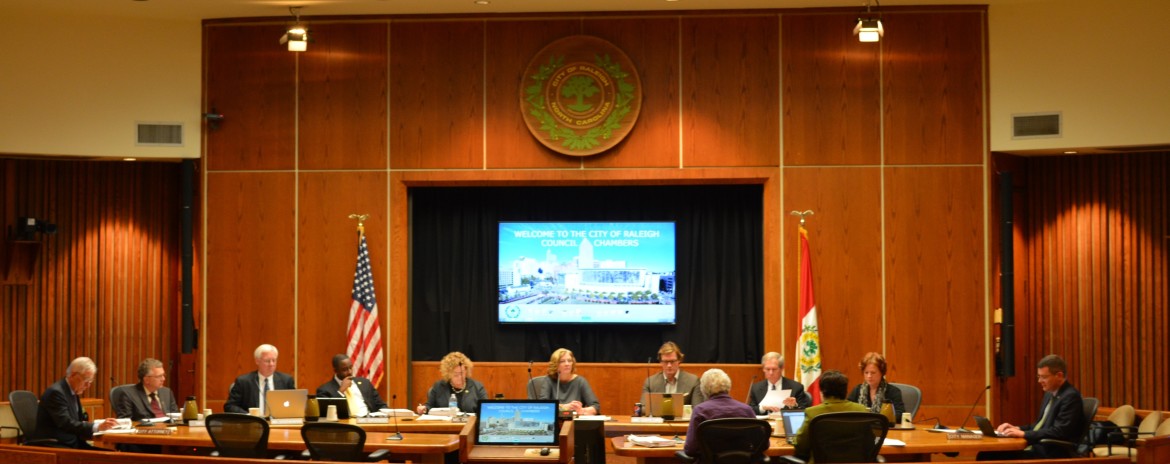Last week, we previewed what would be coming up at City Council with our Agenda Preview, an in-depth look at the issues scheduled for discussion before council. Today, we bring you The Council Record, an informal but nevertheless comprehensive look at the most recent City Council meeting.
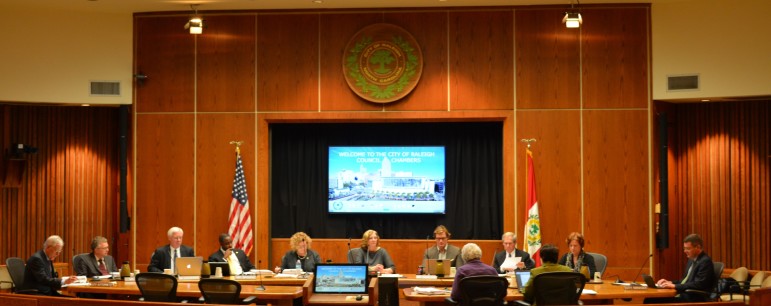
February 1, 2016
You’re not reading that wrong — although City Council had an afternoon and an evening session scheduled for Tuesday, February 2, it held a Special Meeting on Monday night where Councilors adjourned into a closed session after just 36 seconds.
About 17 minutes and 13 seconds later, they reconvened, briefly. Mayor McFarlane announced they had voted to authorize the City Manager and City Attorney to “enter into negotiations with the state of North Carolina to acquire the necessary easements to permit the city to build the restrooms and food facility as shown on the adopted Moore Square Plan.”
Less than a minute — 55 seconds, to be precise — after returning from their closed session, the Councilors voted to adjourn. The entire meeting lasted a mere 18 minutes and 7 seconds. Of that, about a minute and a half was in front of the public.
February 2, 2016
As always, the Raleigh City Council meeting last week began with an invocation, led this time by Revered Mike Raley and the Pledge of Allegiance, led by Councilor Bonner Gaylord. Councilor Corey Branch was absent from the afternoon session.
Presentations & Awards
Mayor McFarlane announced there were no awards being handed out this week, so they moved right on to a presentation from Jerome Davis of the Burning Coal Theatre Company.
Davis noted that they had prepared a very nice digital presentation, but technical difficulties meant he would have to improvise and do it himself.
“That’s what theater is all about,” he noted, before launching into a speech about how attendance last year had been the highest in their 19-year history, that they’d averaged 90 percent capacity and had worked with a number of other community organizations, including Wake County Public Schools, to help further their mission.
For the 2015-2016 fiscal year, the City handed out $1.66 million in arts grants; Burning Coal received $84,515 of that. They requested $110,000.
Consent Agenda
No Councilors requested for any items to be pulled from the Consent Agenda this week, but Mayor McFarlane said the City Clerk had informed her that item 9.2 had to be removed from the agenda.
Item 9.2 dealt with a minor right of way condemnation request for some small pieces of land that the City needs to acquire in order to qualify for a Brownfields grant. The City presently owns the surrounding parcels, which are located at the southeast intersection of East Martin and Bloodworth Streets.
The rest of the Consent Agenda was passed unanimously. For a breakdown on what was approved, check out our Agenda Preview from last week.
Report & Recommendations of the Planning Commission
Ken Bowers, the City’s planning director, gave a very quick rundown on what happened at the last Planning Commission meeting. Commissioners had recommended for approval two rezoning cases, Z-44-15 and Z-45-15, and staff was suggesting that a public hearing be scheduled for both of them on February 16.
Councilors voted unanimously to schedule the public hearings.
For a more in-depth look at what was discussed at the previous Planning Commission meeting, see last week’s Development Beat: Planning Commission Report.
Special Items
The first special item at last week’s Council Meeting dealt with something that was originally part of the Consent Agenda for the January 19 meeting — the Safelight Interlocal Agreement with Wake County Public Schools.
Under the agreement, the City transfers its revenues from the Safelight red light camera program to WCPSS. First-term Councilor Dickie Thompson asked that the item be pulled so he could study the issue further.
Thompson apparently noticed the same thing we did when we first reported on it in our January 18 Agenda Preview: the program brings in a lot of money.
“The proceeds have grown exponentially over the last three years,” Thompson said.
“In 2013 it took in $106,000, in 2014 just over $500,00 and last year it exceeded $828,000.”
Thompson went on to explain that he is very passionate about substance abuse and rehabilitation “especially when we can get involved with our youth in our schools.” He noted that Wake County was suffering from a heroin epidemic, and asked that the City Manager request from WCPSS that a portion of the proceeds from Safelight be set aside for substance abuse counseling and treatment.
The motion to approve the agreement along with a request that some of the money be spent of substance abuse counseling was approved unanimously.
The next item on the agenda was for a two-hour parking zone on Toxey Drive. Council voted to approve this measure at its last meeting, but did not have the six votes that are required to approve an ordinance on first hearing, they were required to vote on it a second time.
However, Councilor Branch had requested that the item be held to the evening session, when he would be present to vote. The other Councilors agreed to do so.
The final special item was for rezoning case Z-15-15, which would rezone a property on Spring Forest and Atlantic Avenue to allow for the development of two buildings on the land, rather than the current cap of one. The public hearing for the case was heard at the January 19 meeting. Councilors closed the hearing at that time and granted the applicant permission to submit revised conditions.
Those conditions, which restricted medium and high-profile signage from the property, were submitted to the City in a timely manner. Councilors voted unanimously to approve the rezoning.
Report of the City Manager
City Manager Ruffin Hall prefaced his report with the warning that there were “several presentations and topics” because there was “certainly a lot going on in the city of Raleigh right now.”
The first of these presentation was a follow-up from the January 19 work session regarding the RFP process for the City’s Municipal Service Districts. After receiving feedback from the Councilors, staff put together a draft proposal.
Hall said Council could send the draft back with any suggestions, and noted they could also hold a public input process to get community input on the process.
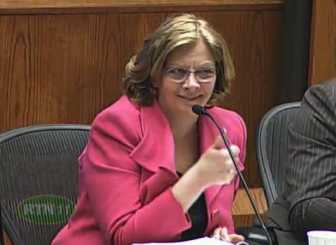
Mayor Nancy McFarlane Approves
Mayor McFarlane said it appeared as if staff had successfully captured Council’s ideas.
Councilor Russ Stephenson said he wanted to ensure that whoever is running the MSDs is familiar with the city’s larger planning goals, including the Hillsborough Street Revitalization.
Councilor Mary Ann Baldwin pointed out that they had discussed retail recruitment specifically, while the draft only mentioned “business recruitment,” something she believes needs rectifying.
Mayor McFarlane agreed and said they need to determine a balance of what a healthy mix between retail and services would be. She proposed setting a Public Hearing for February 16 in order to get input from the public on the process.
This was followed with a presentation on the City’s employee compensation study, a lengthy undertaking that seeks to establish clear and effective compensation and staff retention policies.
Steve Jones, the City’s Human Resources Director, said it was important as the city grows and transitions to recruit and retain a diverse, high performing workforce. The foundation of this, he said, was making sure that the City offers a competitive pay structure.
“This project will take well into 2017 for us to complete; I think of it like a marathon. The first 10K is behind us.
“The toughest part is right in front of us; because it’s such a large project that ultimately affects all employees, we decided to break it into phases.”
Ronnie Charles, a compensation consultant from Gallagher Benefits Services, said the recently completed phase one had helped put in place some of the fundamental foundational principles necessary to help identify the appropriate benchmarks, such as what other cities Raleigh is competing against for staff.
Studies such as this, Charles said, are typically done every three years; it has been more than 12 since one was done for Raleigh.
“This one’s well overdue,” he said.
Charles said the study had found that while the City does not have a formal defined compensation philosophy, it did work with several focus groups and City leaders to put together a draft consensus compensation philosophy.
The philosophy begins with the notion that its employees are its most valuable assets, and to that end, Charles recommends the City take immediate action to update the current job descriptions, which are at present outdated and may open the City up to litigation.
“You have a pretty good system in place, but there are areas that really need to be improved,” he said in closing.
The next presentation shifted Council’s focus from new and innovative ways in which the City could spend money to a new and exciting way in which it might take in some money: a $60 million grant from the US Department of Transportation.
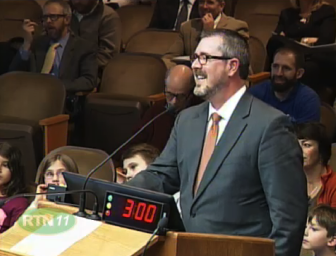
Transportation Planning Manager Eric Lamb
Raleigh’s Transportation Manager Eric Lamb had previously addressed the Council on January 19 regarding the grant; at the time, approval was required to move forward with an application on the grant, which was due February 4.
The grant is designed to “incentivize mid-sized cities to utilize innovation and emerging technology to improve safety, enhance mobility, protect the environment, and provide people with better access to jobs, schools, and essential services.”
The City partnered with NC State to work on the grant, and focused on how to grow the existing transportation network without increasing congestion. Three key areas of focus were developed, and they included smart travel, the establishment of a sustainable smart fleet of vehicles and first/last mile automation, designed to extend the reach of transit utilizing small, automated vehicles.
Five finalists will be selected from the pool of applicants, and each will receive a grant of $100,000 to produce a more detailed application, which will be due in May 2016. The winner of the $60 million will be announced in June.
Councilor Baldwin expressed her excitement for the endeavor.
“I do want to say, I am so excited about this; I do this for a living, putting together these kind of applications, so I know and understand the work that goes into this. You guys are to be commended, this is awesome stuff.”
Mayor McFarlane agreed, and said to Lamb:
“You’ve been working so hard — that’s why your voice is hoarse.”
This was followed by another, but significantly longer and more detailed, transit-focused presentation. Carter Pettibone from the City’s planning office was on hand to provide an update and presentation on the study.
The study, Pettibone said, had been going on “for quite a while; many hours of staff and citizen input.”
When developing the study, he said, “above all, we wanted to make a unique sense of place for the area, and we heard people wanted to be able to walk up and down, to ride bikes up and down and across Six Forks, and to do it safely.” Therefore, safety, along with enhancing alternative modes of travel, became key components of the plan.
Councilors had a number of questions, many of them involving current traffic issues. Mayor McFarlane asked about a light planned at Loft and Six Forks, noting “That’s a difficult area right now.”
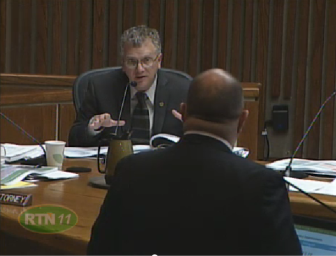
Councilor David Cox
Cox asked about the possibility of a pedestrian bridge at North Hills, saying it was dangerous for anyone to cross six lanes of traffic in order to get from one part of North Hills to the other. Pettibone said while this had been considered, the cost and difficulty of getting such a structure built was beyond the scope of the planned improvements for the corridor.
It was suggested that the study be further discussed in a Council work session, to which several “key stakeholders” involved with the plan will be invited and given the opportunity to offer feedback and suggestions. The City’s website for the plan can be found here.
The final portion of the City Manager’s report was simply a list of follow-up items from the retreat involving the scheduling of Bi-Weekly work sessions. Councilors, Hall said, would also be receiving their agenda packets on Thursdays instead of Fridays, beginning the following week. Several Council members expressed their excitement over this and approved the follow-up items unanimously.
Raleigh Arts Commission Report
Jerry Bolas from the City’s Parks, Recreation, and Cultural Resources department was on hand to introduce the Raleigh Arts Plan, Creative Life, a “10-year master plan to strengthen arts and culture throughout the City.”
Bolas said there had been five initial planning goals when work began on the plan: nurturing creativity and opportunities to live creatively throughout the city, growing participation in the arts citywide, encouraging support for the arts and for arts organizations and amplifying public and private investment in the arts.
“The community has spoken, more than 4,000 folks from the area have contributed to this,” Bolas said.
Jerry Allen, who helped develop the plan, presented a seven-minute summary to Councilors. Citing the time limit, Allen joked “I’m going to move this from 45 RPM to 78 RPM.”
The goal, Allen said, was to strengthen the arts and culture for all of the city’s many communities and people. “This is a plan for the residents of this community,” he noted.
Allen praised the input they had received from Raleigh’s many citizens.
“Sometimes the best ideas aren’t the ones the consultant brings to the table, the best ideas bubble up from the community.”
The five initial goals expanded into eight, Allen said: participation by anyone who wants to in the arts, youth involvement, improved inclusion and equity efforts, the support of artists and cultural organizations, making arts and creative districts, create nodes of art, a public art master plan, the long-term goal of a new performing arts venue, the consolidation of arts programs, and a sustainable source of funding, which would be created through an Arts and Culture Foundation.
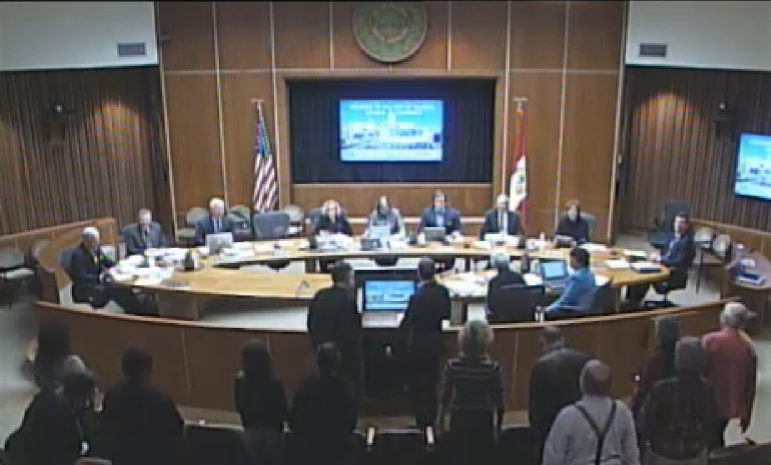
A large crowd turned out in support of the Arts Plan
Following the presentation, first-term Councilor David Cox said he spotted the “Before I Die” project on one of the slides, which had been on Fayetteville Street in downtown Raleigh last summer.
“I wrote on it, before I die, I want to run for City Council,” Cox said. The room burst into laughter and applause as he continued:
“I am proof positive that the Raleigh Arts can have a dramatic effect on your life.”
Historic Development Commission Report
Councilors moved quickly on the recommendations of the Historic Development Commission, which will schedule an April 5 Public Hearing “to receive public comment on the historic landmark reports and proposed landmark designations and modification.”
Council Committee Reports
While none of the Council’s newly-formed committees had reports to present last week, Councilors did spend six minutes discussing a possible name change for one of those committees.
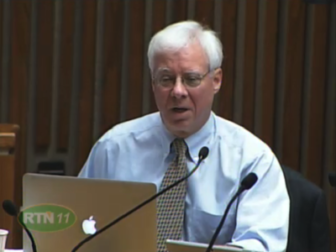
Councilor Russ Stephenson
Councilor Russ Stephenson, who chairs the The Safe, Vibrant and Healthy Neighborhoods Committee, proposed that its name be changed simply to the “Healthy Neighborhoods Committee.”
When asked by Mayor McFarlane if he wanted to make it an official motion, Stephenson agreed.
Councilor Baldwin argued that the committee names were chosen for a reason, and were intended to reflect goals laid out in the comprehensive plan. Because Stephenson’s committee deals with safety, vibrancy and health issues, renaming it to the Healthy Neighborhoods Committee diminished those other aspects.
“Why do you need a motion to do this?” Baldwin asked. “You can call it whatever you want.”
McFarlane agreed, noting “You may refer to it at the table however you like.”
Stephenson persisted, saying he didn’t want to create confusion among Councilors or members of the public when he referred to the “Healthy Neighborhoods Committee.”
People may not remember that this is the same as the “Safe, Vibrant and Healthy Neighborhoods Committee,” he argued.
“I think we’ll remember this conversation,” quipped McFarlane.
“You could put ‘Healthy Neighborhoods’ in parentheses” on the agenda, Stephenson suggested earnestly.
“What’s the motion here? To put it in parentheses on the agenda? I can get behind that,” joked Gaylord.
“I think we have a motion and a second, but I don’t know what it’s for,” remarked an increasingly exasperated McFarlane.
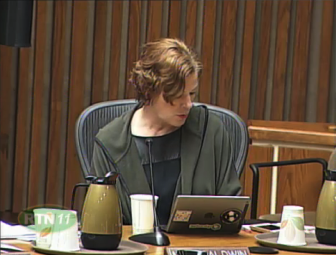
Councilor Mary Ann Baldwin
Councilor Baldwin proposed a substitute motion: “We do nothing.”
“Mr. Stephenson can call it whatever he wants; I don’t understand why we need a motion to do anything,” Baldwin said.
Stephenson refused to relent.
“I just want to make sure the public is aware if they see something called ‘The Healthy Neighborhoods Committee’ they’re not confused; if we can unofficially provide guidance to people…” he said.
“The name; it’s just long, verbose, and I’d like to shorten it to be more convenient for everyone who uses it; it doesn’t have to be official, it just has to be widely known if they hear it. The motion would just be to let people know when I refer to it as the Healthy Neighborhoods Committee that it’s the same as the official name that’s too long to say.”
“Are you proposing we have ‘Healthy Neighborhoods’ on official documentation?” asked Cox.
“No,” replied Stephenson.
Mayor McFarlane suggested they simply take Stephenson’s remarks as a statement, and not make an official motion.
“I can’t promise I’ll understand,” Gaylord warned, before being cut off by the Mayor, who quickly moved Council along to the next agenda item.
Individual Councilor Reports
Councilor Kay Crowder was up first, with a request that $5,000 from the Council’s contingency fund be transferred to the Raleigh City Cemeteries program in order to digitize photographs of the city’s cemeteries. Crowder noted that following the 2011 tornado that struck the city, FEMA workers found the organization’s cemetery photos useful.
The motion to grant the funds was approved unanimously. Crowder also requested that a work session be held to discuss the Upper Neuse Clean Water Initiative, which will be coordinated with staff.
Councilor Bonner Gaylord was next, with a report on “something exciting happening in District E.”
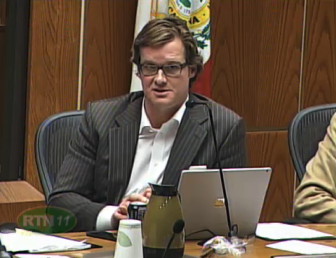
Councilor Bonner Gaylord
Gaylord announced that he was planning to hold monthly District E Neighborhood Alliance meetings at Glen Eden Park. These meeting would give residents an opportunity to discuss issues facing their district. At an introductory meeting for the concept, Gaylord said, more than 40 people expressed interest in the concept.
Councilor Dickie Thompson offered an “attaboy” and a “attagirl” to City staff for doing a “bang-up job” in dealing with last month’s snow and ice event. “I’ve heard a lot of positive things from citizens on how that was handled,” Thompson said.
Councilor Mary Ann Baldwin brought up signage for the Convention Center, saying they needed feedback from the Convention Center Commission. Current signage, Baldwin said, lack the necessary visual cues, and she wants to move forward with a better design plan. City Manager Ruffin Hall said they would look at the sign ordinance and prepare a report on the way events at the Convention Center and the Red Had Amphitheatre are advertised.
Following this, Councilors broke off into a nearly hourlong closed session regarding the acquisition of a property on Salisbury and South Street, after which the meeting was adjourned.
Evening Session
The evening session began with a series of requests and petitions from citizens.
First up was David Simonton, who alleged misconduct with the petitioning process for street improvements on Lorimer Road. He presented Council with a packet that included sworn affidavits from people who had signed the petition claiming they were misled as to what it was they were affixing their name to. Similar complaints, Simonton said, had also been raised for the Laurel Road project.
He requested that Council suspend the project and investigate his allegations.
Before the next presentation, Mayor McFarlane quickly brought up the two-hour parking on Toxey Drive item that had been postponed from the afternoon session. It was approved unanimously.
Next up was Harold Dover, who wanted to ask that Council look into reducing the fees and requirements for licensed taxi drivers, who were having difficulty competing with ride-sharing services like Uber that do not impose the same requirements. Councilor Crowder noted that she had asked staff to look into this issue last year, and City Manager Hall said he would make sure she gets a copy of the findings.
The final citizen was Margaret “Peggy” Seymore, who had three petitions regarding the Hillsborough Street revitalization project. First, she wanted a “do not block the intersection” sign on the southwest corner of Rosemary and Hillsborough, where a roundabout will be installed.
Next was for a stop sign to be installed on Concord at Stanhope, to help the cars getting out of that lot reduce their speed. Finally, she asked that the city look into further restricting the placement of dumpsters and recycling binds.
Public Hearings
Five matters were scheduled for public hearing.
First up was a sidewalk petition at Orleans Place for a 160 foot sidewalk installation. No one was present to discuss the project, so the hearing was closed and the petition approved by Council.
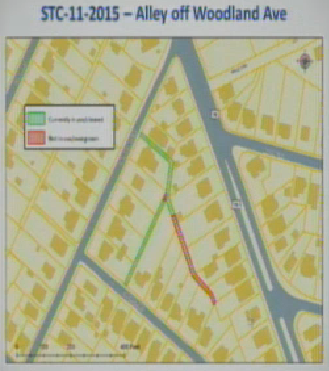
The alleyway in question
Next up was a proposal to close a portion of an unnamed alleyway on Woodland Avenue off Glenwood. The petitioner said the request was in response to an adjacent property owner, who asked that the alley be opened for tenants in his rental property.
Following presentations from both sides, who argued that it would be safer to close the alley and that closing the alley was an unfair restriction to those who wanted to use it for access. Councilors ultimately decided to vote against the petition to close the alleyway.
Council was next asked to approve an assessment on property owners in order to pay for street improvements made to Wakefield Crossings, which is now a city-maintained street. It was initially paved as part of a failed development, and after years of neglect the city agreed to take it over so long as residents paid for the necessary improvements. Council unanimously approved the $5,670 assessment.
Two annexation petitions for the Holden Ridge subdivision and the Sycamore Run Apartments were approved unanimously and without discussion.
The final public hearing of the night concerned TC-1-16, a text change regarding the classification of story heights. Councilor Stephenson had initially expressed concern that the new language was not precise enough; story heigh will now be measured as being from the top of a finished floor to the top of the finished floor above it. Staff agreed that this wording was acceptable, and the text change was adopted.
